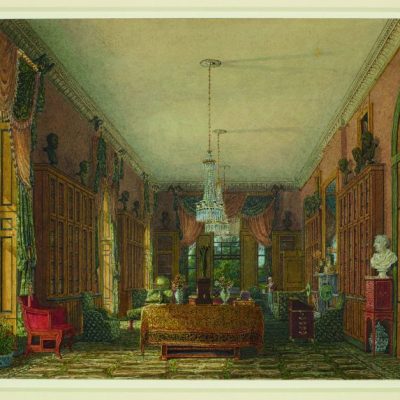The present campaign to abolish slavery including enforced prostitution in this great metropolis echoes local initiatives 300 years ago. Sir John Fielding addressed the problem captured by artist William Hogarth in the early 1730s. Hogarth’s engravings for A Harlot’s Progress evoke the fate of a naive country girl from Yorkshire unwittingly duped by the notorious brothel keeper appropriately named Mother Needham.
The founding 20 years later in Whitechapel of The Magdalen Hospital for Penitent Prostitutes provided a cure and The Asylum for Female Orphans in Vauxhall, the necessary prevention. The Asylum occupied a former pub called the Hercules Pillars and aimed to ‘preserve friendless and deserted girls from those dangers and misfortunes, to which their distressed situation exposes them’. Both attracted the patronage of Queen Charlotte, the Archbishop of Canterbury, and other leading members of the establishment. Six penitents were admitted to the Magdalen Hospital on the first day and by 1769, 1500 had taken refuge. Due to increased demand, in 1772 a purpose-built Magdalen ‘hospital’ opened in St George’s Fields, Southwark, headed by a subscription of £300 from the Queen. The building included a non-denominational octagonal chapel in which residents worshipped behind a screen. They were thus shielded from the scrutiny of well-heeled citizens attracted to attend the daily services by the beauty and mystery of the choral singing. Collections from visitors during these services contributed to the costs of maintaining the charity. The Asylum was rebuilt in 1824; their Sunday chapel services attracted supporting visitors who observed the clean and healthy appearance of the children.
The glass cup and paten, made for use in Holy Communion celebrated in the Chapel of the Magdalen Hospital, Southwark, (1775) unknown maker, London. Victoria and Albert Museum

The Magdalen chapel communion cup and paten now in the V&A’s sacred silver and stained glass galleries are made unusually of glass. They are engraved in gold lettering THE MAGDALENE CHARITY THE GLORY BE TO GOD and decorated with golden sprays of foliate decoration. The use of glass for this purpose is rare, if not unique, and was probably chosen as being of a lower security risk than silver. Adjacent to these sacred glass vessels, a handsome silver Communion set from the chapel of the Asylum of the Female Orphans proclaims the philanthropy of Sir Thomas Hankey, City banker. Commissioned from Abraham Portal, former apprentice of the celebrated goldsmith Paul de Lamerie, Hankey’s generous donation is clearly inscribed on each of the vessels; the communion cup, paten, flagon, and alms dish; Hankey’s coat of arms proclaims his social status.
Across Hyde Park ‘Enlightened Princesses: Caroline, Augusta, Charlotte and the Shaping of the Modern World’ reveals further documentary evidence for both the Magdalen Hospital and the Asylum. William Dodd (1729–77) an evening preacher at the Magdalen Hospital chapel was responsible for the published 1770 account of that charity. Ironically Dodd was the last person to be hanged for forgery at Tyburn Gallows. His text, loaned by the Wellcome Library, explains that women had to be under 30 years of age and sincere in their desire to be reformed. Preference was given to the youngest applicants with the least experience of prostitution. Training was provided in needlework and laundry. Religious services had to be attended twice daily. The average length of stay was three years.
The silver cup, paten, flagon, alms dish for use in Holy Communion celebrated in the Chapel of the Asylum of the Female Orphans, Vauxhall, (1763–34), maker’s mark of Abraham Portal. Victoria and Albert Museum, London

The account of the Asylum for Female Orphans published by The Philanthropic Society in 1809 expands on the earlier 1761 version (both are shown at Kensington Palace, loaned by the Beinecke, Yale, and the Wellcome libraries). They provide a detailed account of the diet, employment and education of the girls; they were taught to read the Bible. At 15, the children were apprenticed ‘as domestic servants in reputable families residing in England; the greatest care being taken by the guardians themselves to enquire into the characters of masters and mistresses, before the children are entrusted to them’.
The Magdalen Hospital continued to offer opportunities for reform and in 1778 also welcomed victims of seduction. During the first half of the 19th century expenses in the upkeep and repairs to the building increased. The district became unhealthy, with factories and overcrowded dwellings. In 1869, the site was sold for redevelopment by the Peabody Trustees as tenement housing, and the Hospital moved to Streatham. In 1913 the installation of a central laundry provided much of the Hospital’s income. In 1934 the Hospital became an Approved School for female offenders and in 1938 the words ‘for the Reception of Penitent Prostitutes’ were dropped from its title.
During the Second World War the Hospital was evacuated to Ottershaw, Surrey and the building used as a refugee centre. In 1944 it became the Magdalen Hospital Classifying School, where girls were sent for assessment by Juvenile Courts in the south of England before their future was decided. That school closed in 1966 and the site was bought by Lambeth Council. The Magdalen Hospital Trust was dissolved in 1973.
The Asylum moved to Carew Manor, Beddington, near Croydon, Surrey, providing accommodation for 150 girls aged seven to ten. Their curriculum of reading, knitting, sewing, making beds, and kitchen work equipped them to become good housewives and members of society. They were apprenticed or employed from the age of 14 and an award of two guineas given after the successful completion of two years’ service.
The V&A’s acquisition of the remarkable communion vessels from the chapels of both charities during the 1980s provides an aesthetic witness to philanthropic endeavours of generations of Londoners.
‘Enlightened Princesses: Caroline, Augusta, Charlotte and the Shaping of the Modern World’ is at Kensington Palace, London until 12 November, 2017.
An international conference ‘Enlightened Princesses: Britain and Europe, 1700–1820’ has been organised by Historic Royal Palaces, 29–31st October.


